#RadioLab
Explore tagged Tumblr posts
Text
we need a new vaporwave but for 00s public radio. bj leiderman NPR theme songs. tinny renditions of Beethoven by the local symphony orchestra. the static fuzz when you're driving into the no-mans-land between radio stations. search your feelings you know it to be true
#radiolab#NPR#WHERE is my morning edition theme song remix#WHERE is my synth cover of the opening theme to WHYY All Things Considered
14 notes
·
View notes
Text
when you hear that:
wait, wait, youre listeni-
okay? 🤔
alright. 🤭
okay? 🤔
alright. 🤭
YoUrE LiStEnInG 👾🖥🫂
to Radiolab 💇♀️
radiolab 🤵♂️
From 💅
(rAdIoLaB 🤪)
wny 😮💨
C 🗣
c? 🤔
12 notes
·
View notes
Text

This week, we talked about our favorite podcasts (podcastception)! Check out our top non-fiction recs (after you listen to our latest episode, of course!😁)
#endapartypod#h2eap#podcast#radiolab#atwwd#parcast tales#parcast mythology#the moth stories#criminal podcast#maintenance phase#ear hustle#evangelicalish
2 notes
·
View notes
Text

14 notes
·
View notes
Text
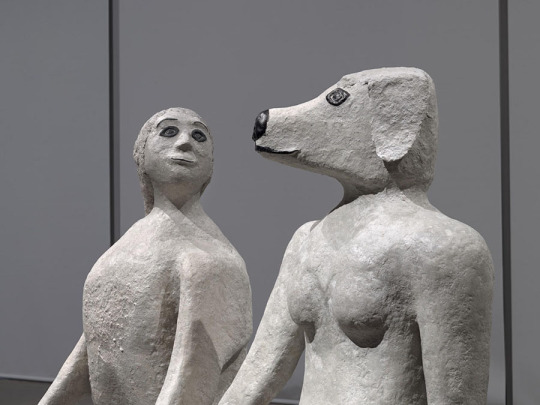
"In this segment, we take an emotional left turn to a story of a very different kind of lost and found. We begin with a college student, Alan Lundgard, who fell in love with a fellow art student, Emilie Gossiaux. Emilie's mom, Susan Gossiaux, describes her daughter, and the terrible phone call she received from Alan nine months after he became Emilie's boyfriend. Together, Susan and Alan tell Jad and Robert about the devastating fork in the road that left Emilie lost in a netherworld, and how Alan found her again."
Finding Emilie.
2 notes
·
View notes
Text
More news about Venus' quasi-moon.
5 notes
·
View notes
Text
Fly with us, lesbian seagull. This week Radiolab’s Lulu Miller brings us a story of queer nature and scientists in denial, featuring seagulls, penguins, rams, swans, dolphins, and—maybe the gayest animal of all—humans.
To learn more about the seagulls, and hear much more of Lulu’s story, check out Radiolab’s amazing new episode.
#lesbian seagulls#you're wrong about podcast#you're wrong about#lulu miller#radiolab#science#lgbtq history#lgbtq rights#LGBTQ#queer history#biology#nature#podcast#podcasts
7 notes
·
View notes
Text
started listening to radiolab again and ohhhhh my god i forgot how much the sound design in this show fucks.
8 notes
·
View notes
Text
JENNIFER BRANDEL
Invisible Landscapes
Scientists' recent discovery of a "new" part of the human body, the interstitium, is an invitation to think differently about our relationship with the world at large
This essay is a companion piece to an episode of Radiolab, titled The Interstitium. You don’t need to have heard it for this essay to make sense, but listening to it will no doubt enrich your understanding.
IN 2018, SCIENTISTS discovered a new organ (?) in the human body. You’d think after centuries of cutting ourselves open, we’d know the intimate details of the structures within us by now. Strangely, this body part wasn’t missed because it was invisible; it was overlooked because of what our belief systems wouldn’t let us perceive.
Until quite recently, if doctors wanted to study human tissue from a living person, they had to remove it first. Then they’d essentially mummify it: drying, freezing, slicing, and fixing it on a slide so they could peer at its shriveled dead form under a microscope to ascertain what was happening at a cellular level. As a result, scientists and doctors were taught in medical school that collagen tissue is essentially a dense wall: a barrier.
But a new endoscope, a microscope that snakes into the body through one of two holes (pie- or butt-), now enables us to see and study living tissue inside a breathing body with a beating heart. And once this special endoscope shone its light just below the skin into the collagen layer, it revealed something much more like a sponge than a wall, with fluid rushing between a fractal, honeycombed network.
The ‘they,’ here, of course doesn’t include everyone. Where Western, allopathic medicine focuses on isolating and treating symptoms, Traditional Chinese Medicine has for 2,500 years looked at the body as a dynamic, fluid-oriented system, and takes a more holistic approach to understanding root causes of discomfort and disease. Western doctors and scientists have often lacked the rubric to appreciate the efficacy of acupuncture, despite studies by reputable bodies like the NIH showing its measurable benefits.
Nor have Western doctors come to fully understand and appreciate the role of fascia — the dense collagen network that supports the structure of our musculature and keeps our bones and body aligned. Rolfers, Osteopaths, myofascial workers have been working for years with fascia structure and the fluid within it, looking at the health of the entire body through a lens of interconnection, dependent relationships, and movement.
We now have a shared language, or at least a word, for this system — or this organ, or this infrastructure (depending on whom you ask) — that’s been revealed as a fluid-filled superhighway spanning the entire body. It’s called: the interstitium. It’s such a new word that my autocorrect feature keeps wanting me to change it to “interstitial.”
Here’s just a glimpse of what’s becoming known about it. The structure of the interstitium is fractal; it exhibits the same pattern at various scales. It’s unified. While scientists had seen glimpses of this mesh-like network before, they had not realized that it connected the entire body — just underneath the skin, and wrapping around organs, arteries, capillaries, veins, head to toes. It’s juicy. It moves four times more fluid through the body than the vascular system does. The fluid isn’t blood, it’s a clear and “pre-lymphatic” substance, carrying within it nutrients, information, and new kinds of cells that are only just being discovered. It’s also a conduit for cancer spread. Turns out that cancer cells moving through the interstitium’s channels are fast.
In short: it’s very important. And it’s wild that, although the interstitium can be seen with the naked eye during surgery, it wasn’t really noticed until now. There is an entire scientific revolution set to unfurl as more studies are peer-reviewed and more science books and classrooms integrate its existence into their cosmologies. We are at the beginning of it all.

I FIRST LEARNED about the interstitium from a friend, Jessica Clark, who does not work in science or medicine. She runs her own business, fittingly called “Dot Connector Studio,” which does work weaving insights across technology, media, futurism, philanthropy, and climate solutions, to name a few domains.
She and I have a lot in common. We do not function well with rigid job descriptions or within organizations. We’re misfits who work on a systems level, transcending any one function and making no sense in a world that wants to explain and contain everything into discrete categories. It’s hard for us to sum ourselves up on LinkedIn or at a dinner party. Whereas job titles are nouns, we’re verbs. This means we get overlooked, and wrongly, sometimes disparagingly, classified as dilettantes, or as Jackie’s of all trades, masters of none.
It turns out, we’re interstitionaries. That is, our work is on all things in between — connecting insights, people and resources between sectors, industries, companies, projects and individuals. Here are two quick illustrations: during early COVID, my company Hearken created infrastructure (technology) and a process to connect public and private institutions including churches, truck companies, hospitals, local businesses as well as individual volunteers to the city of Chicago’s emergency response. The city was able to collect invaluable resources from the network of locals — like N95s, goggles, surgical gloves, hotel rooms for hospital overflow, and people who wanted to volunteer sewing masks and doing contact tracing. And in the journalism and democracy space, we saw the need to connect the best-of resources for reporters on what they can do to combat democratic backsliding, and created The Democracy Toolkit. I can’t give you a number of how many lives were helped or saved by these actions. That’s the nature of field catalyst work: it’s impossible to track the impact, it’s very hard to find flexible funding to do it, but absolutely it’s necessary.
The interstitium’s existence — this golden metaphor rooted in our own biology — has finally given me words for the role I play, and what I’ve been noticing others doing everywhere, but couldn’t articulate. And if anthropomorphizing a body part is wrong, I don’t want to be right.
Just as scientists can now see the interstitium everywhere they look, I see these people everywhere who are bridging, connecting and serving as conduits, keeping systems in communication, operable, healthy. Most of these people I see doing this interstitionary work are women. None of them get paid (or paid enough) for the tremendous value they generate in the world. Their kind of genius would never win a MacArthur fellowship, as their expertise is in the magic of how they do, not just what they do. Their impact transcends any one area, and has been essentially hidden from how we organize, track, measure and reward people in our economy and society.
They aren’t just weirdos like Jessica and I who are attempting to build movements and bridge sectors with our work. Interstitionaries show up everywhere. They’re the auntie who knows everyone’s birthday, favorite foods and friends. They play the role of that invisible glue holding the relationships within a company together — knowing everyone from the CEO to the custodial staff. They are block club captains, organizers, hosts — people who are looking at the whole picture, making sure goods, services or information is getting where it needs to go, and that things work.

THE REASON I’M so hyped about this discovery, despite my last science class having been decades ago, is that the interstitium is a conceptual skeleton key, unlocking a more sophisticated, accurate way of seeing everything in the environment.
In the early modern period, Western scientists conceived of the world in terms of parts, of individuals. Everything was seen as a unit. A molecule, a cell, an organ, a person, a … noun. That’s no accident. The microscope plays an outsized role.
Before microscopes were invented, the composition of the body was a matter of philosophical debate. Aristotle, for instance, believed that the heart was the seat of intelligence and that the brain was a cooling mechanism for the blood. There were long-held beliefs attributed to divine influences, and diseases and recoveries were due to the favor or wrath of deities.
And if anthropomorphizing a body part is wrong, I don’t want to be right.
But once the microscope came along, it ushered in a worldview premised on individual identity. The first eyes to peer through those early eyepieces spotted what looked like empty boxes. English scientist Robert Hooke in 1665 coined them as “cells” because they reminded him of the small rooms where monks lived in monasteries. This formative moment led to a worldview called “cell-doctrine” — focusing on things — cells, this basic unit of life from which all living things are composed. Similar cells bundle to form tissues, which then cooperate to form organs, which then carry out the functions necessary to sustain the life of an organism, was how the thinking has gone.
We didn’t pay attention to all of the dynamic, fluid phenomenon, unseen and in between, which connects the organs to one another, and allows the whole system to communicate and stay in homeostasis.
And we grafted this same thinking onto how we organize labor and society. Similar people bundle to form departments, which then cooperate to form companies, which then carry out the functions to sustain our collective communities, countries and world. The enforcement of this model starts young. We ask children, “what do you want to be when you grow up?”, not “how do you want to be when you grow up?” We divide knowledge into subjects, disciplines, majors, then sectors and industries and specific job titles.
We need more navigators skipping between these constructed categories to subvert and replace a perspective of separation that has reached its limits and logical conclusion.

AT A RECENT conference for a movement I accidentally co-founded which is now woven into the economic policy of Japan, I met a fellow named Arthur Brock, who, in his own words “builds targeted currencies which shape the social dynamics of our emerging post-industrial economy.” Before I even mentioned the interstitium, Arthur said: “We’re in a paradigm shift. We’re moving away from the scientific way of looking at the world as objects, to seeing a system-based world that’s all about fluid, currents, connections and relationships.”
Exactly. This is the dawning of the age of Aquarius, after all, when the mystics tell us we “shift from matter to spirit; from egotistic materialism and hope for personal redemption to shared feelings and aspirations; from the long ago matriarchal/patriarchal tensions to an age of equality and androgyny.” It’s all about that third thing that envelops the spaces between any two nodes: the relationship, the dynamic, the warm data and the energy that animates their movement, direction, and leaves everything changed through the very act of connection.
Other fields are revealing this same truth, seemingly all simultaneously. Ecologists now perceive the trees in forests as connected to one another, trading information and nutrients across long distances, calibrating an ecosystem’s health. Mycelial networks are now part of conversations of people who, until recently, knew nothing about mushrooms. Cooperative businesses and mutual aid are experiencing a resurgence as more people recognize their own interdependence and trade value with one another.
The National Science Foundation is, for the first time, investing in dialogues between Indigenous knowledge and Western science. A friend in Chicago is trying to create a civic interstitium to connect and cultivate more interstitionary talent to work between agencies and grassroots organizations, improving overall city health. There’s a whole field emerging called Community-based Participatory Action Research for Health, which focuses on understanding community health through studying the network effects of relationships. This focus on relationality and connection is one way out of what our surgeon general calls an epidemic of loneliness and isolation.
Just as happened with the body’s interstitium, technology plays a role in revealing what we can now plainly see, albeit with the help of social graphs and data. Social media companies have mapped, and now essentially own, the complex web of our relationships and movements online to exploit our societal interstitium. With this recognition of our interconnectedness and by providing the tech infrastructure for our information flows, they’ve been able to sell us products, capture our attention, exert power on our systems of thought, governance, and being. Alongside the good information flowing through this infrastructure, they’ve also made it far easier to introduce and spread exploitative sentiments through the interstitium like a cancer in the form of misinformation.

“WE PERCEIVE ONLY that part of nature that our technologies permit,” writes Scott F. Gilbert, Jan Sapp, and Alfred I. Tauber, “and so too, our theories about nature are highly constrained to what our technologies enable us to observe.” In other words, our cosmologies, worldviews, conceptions of the environment and how it works, are limited or expanded by what we can perceive. Our experiences then transmute into the metaphors and grammar that organize our thoughts. New language gives us new worldviews.
The Potawatomi plant ecologist, writer and an actual MacArthur fellow, Robin Wall Kimmerer, writes in Braiding Sweetgrass, “Science can be a language of distance which reduces a being to its working parts; it’s a language of objects.” And in Orion she writes, “The relationship between the structure of a language and the behavior characteristic of a culture, is not a causal one, but many linguists and psychologists agree that language reveals unconscious cultural assumptions and exerts some influence over patterns of thought.”
She wonders, “Can we make a new world with new words?”
Which makes me wonder, how can we activate and apply this new word, interstitium, to harness its meaning and power beyond biology? What will it take to find ways of seeing, languaging and remunerating interstitionary work, so our systems have a chance at correcting and finding balance? No one sector, industry or organization will be able to solve the wicked problems we face in challenges like climate or poverty or corruption. So my last questions are, when can we start, and are you in?
Jennifer Brandel is a serial entrepreneur and innovator who works between industries to address the same problem set: how to design systems that listen, respond and evolve with their stakeholders. Her curiosity and listening-based approach has yielded the kind of change that shifts sectors toward a co-creative paradigm. She is co-founder of Hearken, Zebras Unite, Civic Exchange Chicago, Election SOS, Democracy Day, Advancing Democracy, WBEZ’s Curious City and Dance Dance Party Party. Brandel received the Media Changemaker Prize by the Center for Collaborative Journalism, was named one of 30 World-Changing Women in Conscious Business, is a Columbia Sulzberger Fellow, an RSA Fellow, a member of the Guild of Future Architects and the National Civic Collaboratory.
5 notes
·
View notes
Text

Great podcast episode from Radiolab about games and sports has been added to:
5 notes
·
View notes
Text
real bitches were there in 2012 when Radiolab's "colors" episode aired. real bitches are still singing the mantis shrimp choral motif
8 notes
·
View notes
Text
Important update - Radiolab (and Latif) are having a contest with the international astronomical union to choose the name for a quasi-moon of earth. They got submissions from all over the world, and you can vote here through January 1st 2025! (Or search Radiolab quasi moon to find it)
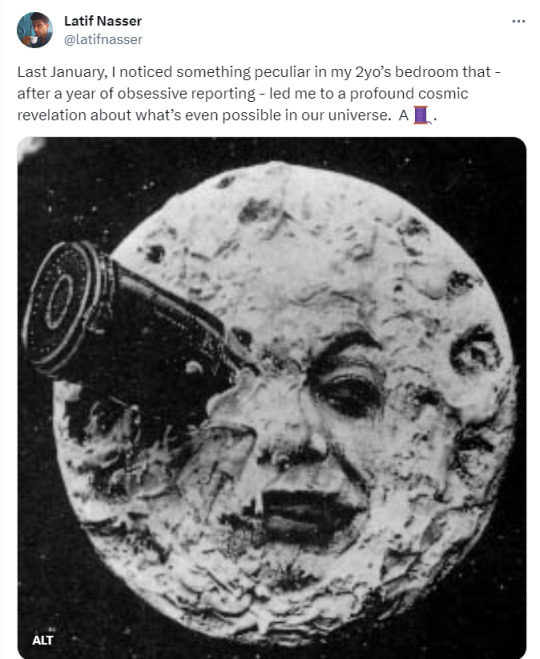
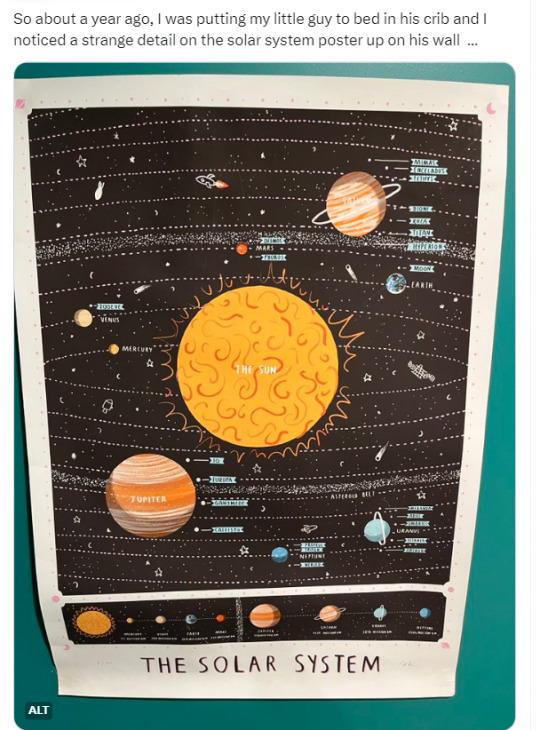
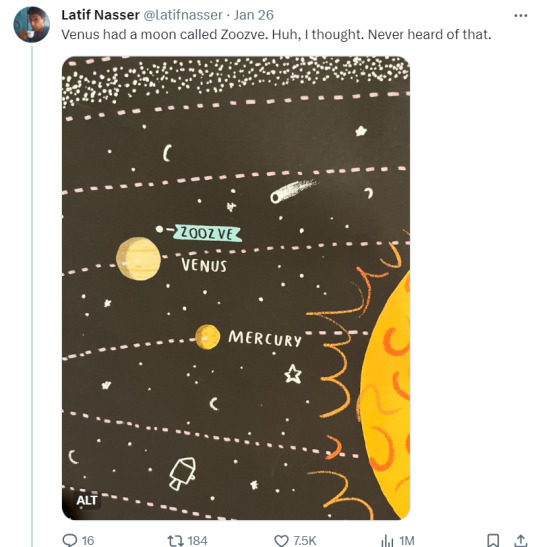
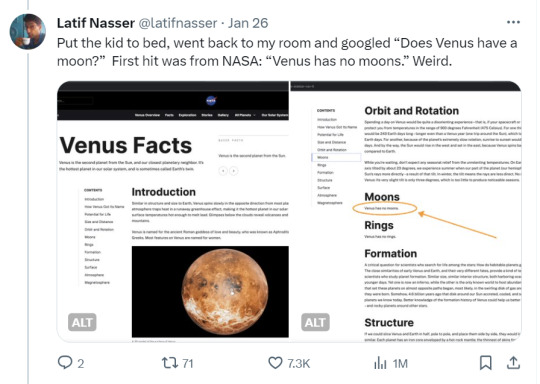
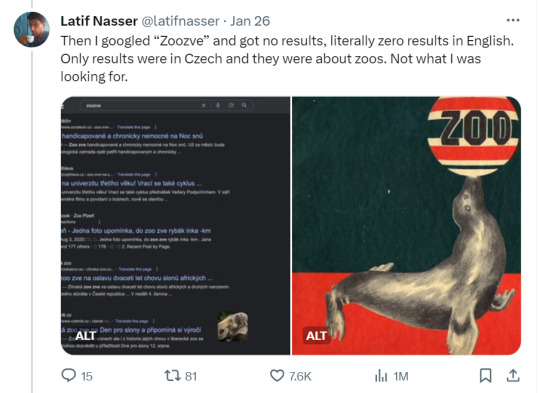
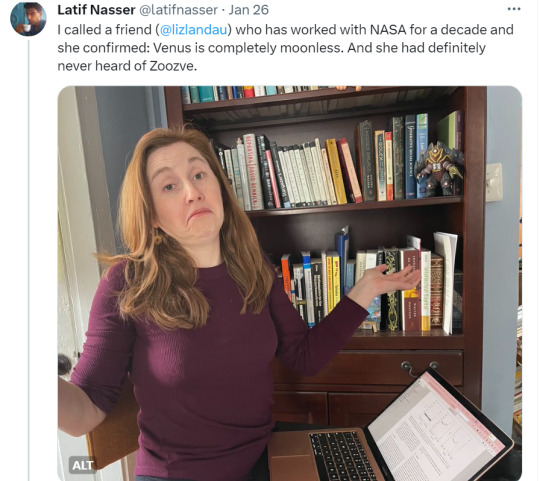
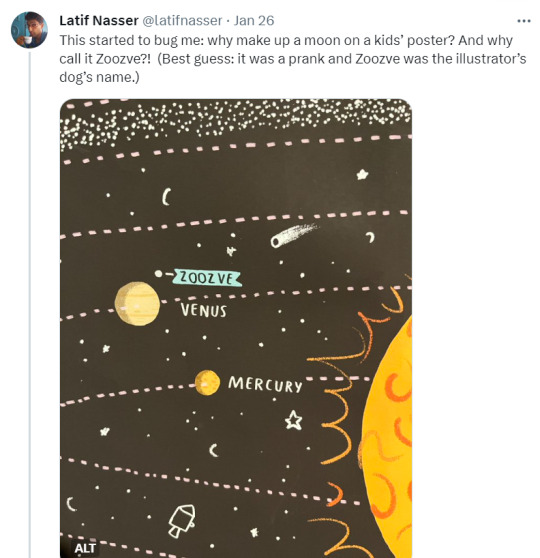
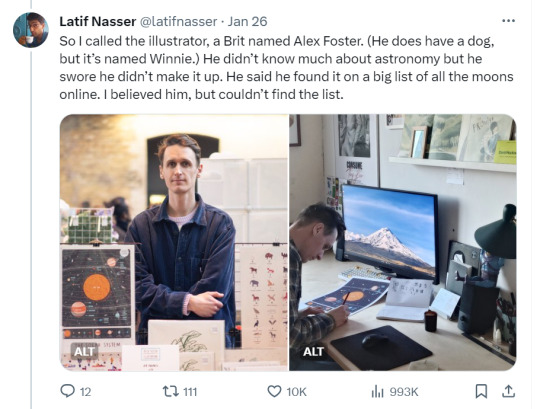

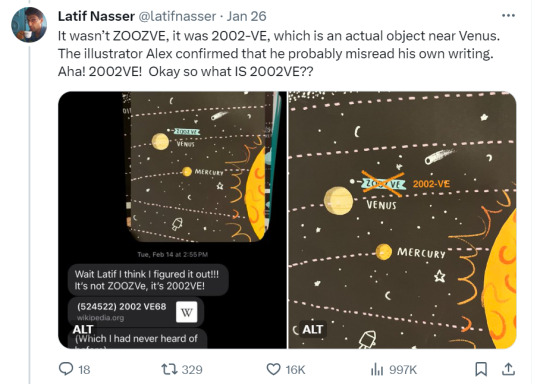

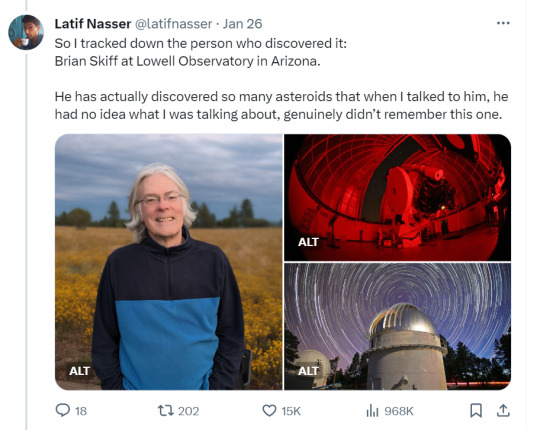
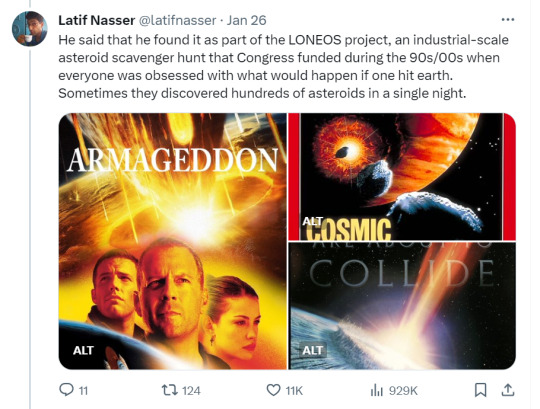
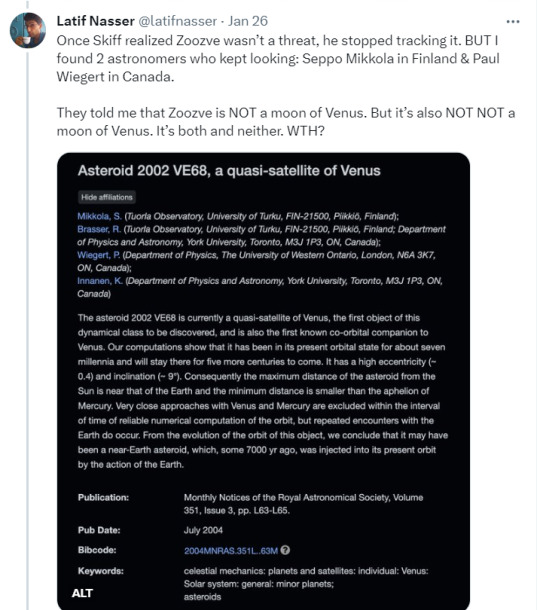
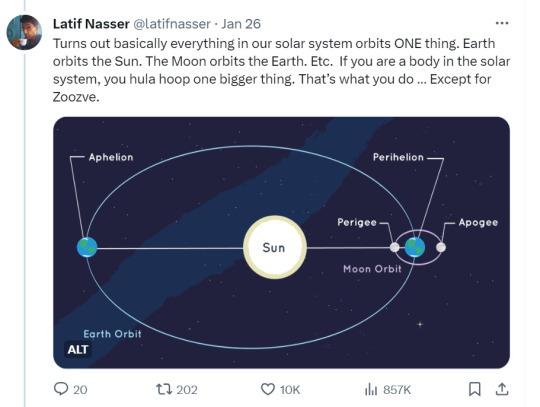
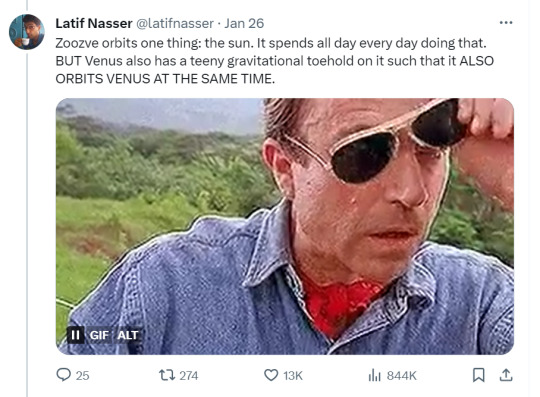
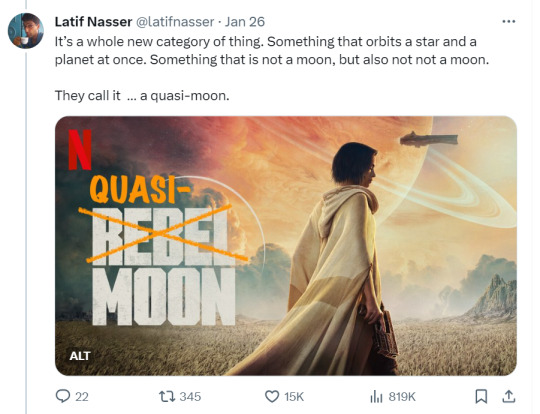
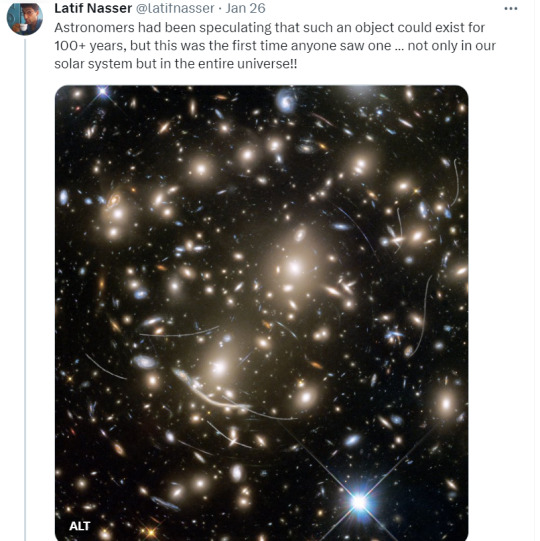


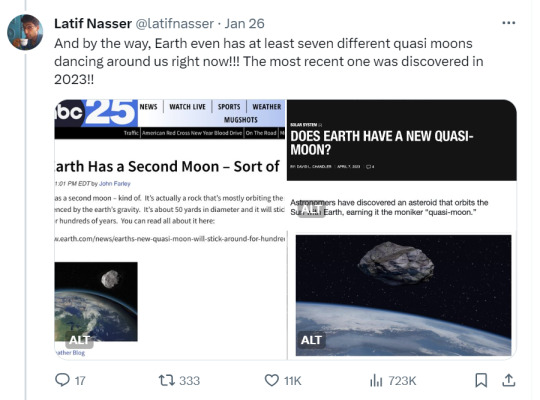

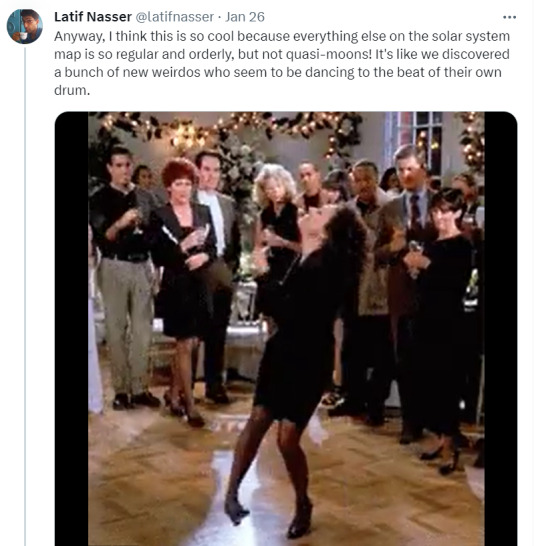
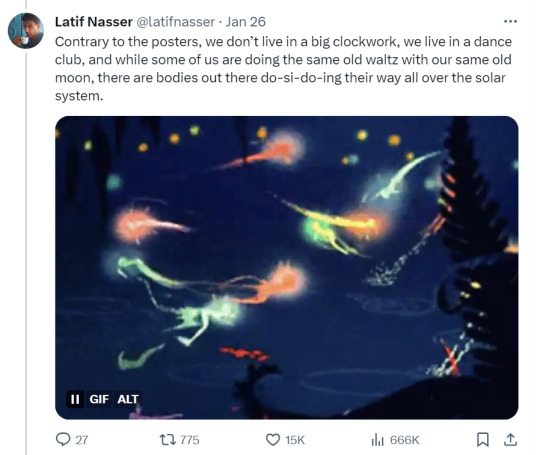
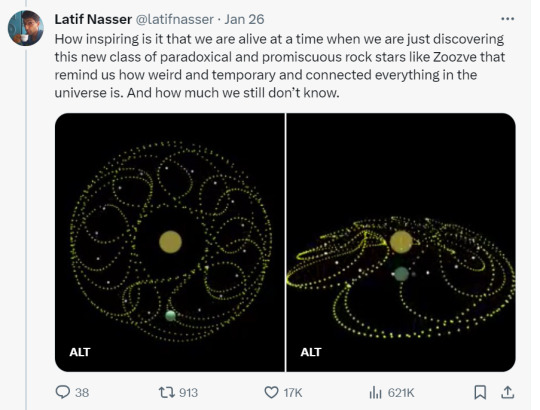

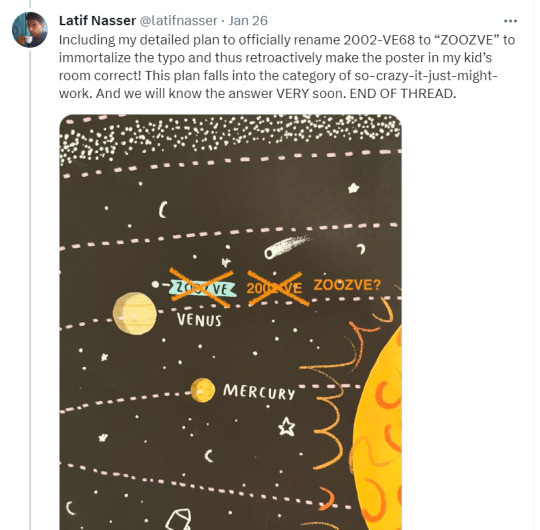
Zoozve, my beloved
152K notes
·
View notes
Text
2024 Book Round-Up
I’m doing this again! These are things I read this year, not books that came out this year. They’re not in any particular order.
The Atrocity Archives by Charles Stross I read this book and the next from this series (the Laundry Files) this year and kind of fell in love. It’s about an agent and IT guy from a secret British agency in charge of stopping demons and other monstrosities summoned by computers from destroying the world. The horror has a very cosmic/eldritch vibe. I also find it quite funny with almost Pratchett-like dry humor, though with a pitch black coat of paint on it. Office politics is also a big part of the stories, but resolved in much more grisly ways than hopefully you’d find in your workplace. There are a lot of books in this series, so I have a lot to look forward to.
Dune Messiah by Frank Herbert Just finished this one. I wasn’t expecting to like it as much as I did. A lot of the book happens inside Paul’s head or through political conversations, but I felt the story still moved along well and had interesting twists and turns. The weirdness of the Dune universe also takes a big step forward which I appreciated here. You could leave the first book still debating if Paul still fits in the typical white savior narrative, and this book shatters that really effectively.
Erasure by Percival Everett I think I heard about this one from an interview with the author on the On the Media podcast. The basic premise is a Black author is critically well-received but not commercially because he writes experimental fiction that publishers and distributors find to be not reflective enough of the African-American experience (something that he’s not trying to write about). He hits a point when he needs money after tragedy hits his family and is frustrated by the market and writes a book about a young man in the hood full of stereotypes that he intends as a scathing parody of other books that are selling well. Minor spoilers, people love the book and take it as an authentic look at the African-American experience. This was more experimental than I was expecting—the entirety of the terrible book the character writes is in this novel—but I found it really compelling. The tension in the last scene had my heart hammering.
Why Fish Don’t Exist by Lulu Miller Another book that landed on my list by way of podcast a long time ago, this book is part biography of ichthyologist David Starr Jordan, part memoir, and part critical examination of taxonomy, eugenics, and the western obsession with classification and hierarchy. It’s a pretty beautiful work that I find myself thinking about and referencing quite often.
The Lies of Locke Lamora by Scott Lynch Want a fantasy book that’s about all rogues? This is that book. It’s a crime/heist thriller in a really well-built world. There’s a great mix of high highs and low lows in this book (warning, it gets dark), and it uses tension really well. The heisting and scheming is all really fun, the magic and monsters of the world are really cool balancing an overall pretty harrowing story.
Raw Dog by Jamie Loftus OK, like most of these I heard about on a podcast. Jamie Loftus has been one of the most common voices coming through my speakers/headphones this year and she narrates the audiobook for her book. This book is about hot dogs, told through a cross country hotdog tour. It’s also about the meat industry, COVID, a relationship at its end, and America’s relationship with consumption. It’s very well written and a good encapsulation of what I love about Jamie’s brand of journalism and storytelling.
Escape from Incel Island by Margaret Killjoy Margaret Killjoy is another favorite person to listen to/read. This book is a pretty short, pulpy romp about a future where all of the incels get tricked by the government into getting trapped on an island and a woman and a non-binary mercenary who are sent to the island and then have to escape. It’s violent, sometimes scary, but doesn’t take that side of itself too seriously. Woven through are some really compassionate and poignant examinations of gender, masculinity, and the complexity of people.
Reading Now/On the Shelf I’m currently reading Lessons in Birdwatching by Honey Watson and loving it. It’s a really cool far-future sci-fi book about research students stationed on a planet where the residents appear to experience time nonlinearly. It will probably be the first book I finish in 2025 and will show up on this list next year.
Also on the shelf are The Sapling Cage by Margaret Killjoy which is marketed as a young adult fantasy novel and The Long Way to a Small, Angry Planet by Becky Chambers, the author of A Psalm for the Wild-Built which I read last year. I’m really looking forward to both!
#books#the laundry files#dune#dune messiah#margaret killjoy#jamie loftus#percival everett#erasure#lulu miller#radiolab#on the media#gentlemen bastards#the lies of locke lamora#raw dog food#escape from incel island#becky chambers#honey watson#lessons in birdwatching#the atrocity archives#why fish don't exist#david starr jordan
1 note
·
View note
Link
0 notes
Text
Great Radiolab story about the quasi-moon of Venus.
#zoozve#quasi-moon#quasi moon#2004-68#Venus#radiolab#three body problem#audio#podcast#latif nasser#solar system#naming#international astronomical union#space#predictability#error#poster#Spotify
0 notes
Text
Listening to an episode of Radiolab called How to Save a Life. And thinking about how very thankful I am that I've had access to regular first aid/CPR classes for the last *20 years* through my work.
There are people in my building who go out on survey vessels every year, and so at least two people became actual certified *instructors* so we could had yearly classes without even having to host an outside person to teach. And even though I don't go out on boats, they throw the classes open to everyone in the building.
I've done the old school compressions-and-breaths on dummies so many times now, and the updated compressions-only/hands-only system as well. I've had a chance to get that movement and rhythm into my bones, to feel how exhausted you get after only 2 minutes so I'm ready and not surprised by it. I've seen all the videos of wacky staged workplace injury hijinks so many times. Even though I'm a theater person and being loud and bossy isn't scary to me, I still take comfort in the rehearsal - "YOU! Call 911! YOU! Get the first aid kit..!"
There was a season where everyone seemed to be pregnant at my workplace. The guys brought in *infant rescussi-annies* for us. No babies would EVER be going out in a boat but they taught us how to do CPR on an infant anyway.
I forget how uncommon this is. That not everyone has had so much access to these classes - not only free for me to take, but done during *paid work time*, that the lessons begin to feel like second nature.
In the Radiolab episode, they mention that the odds of surviving a heart incident are something like 8%, because the public really just doesn't have CPR training. But in casinos the odds go up PAST 50%! There's old people! There's stress! There's a higher chance that someone is going to have a heart incident! But there's also cameras! And every worker in the place has been trained in CPR! So if you're not in a hospital, your next best place to have a heart attack is in a casino. 😂
We've all seen CPR depicted on TV. You know what it looks like, but the feel is so much different - harder, more work, and on TV it almost always results in the victim suddenly breathing again within seconds. In real life... In the Radiolab episode, they talk about a woman who did CPR on her husband for ten minutes before the EMT's arrived. Ten minutes. An eternity. And even then it took five shocks to get him back.
But he wouldn't have come back at all if she hadn't worked her ass off for those ten minutes.
If you can get yourself to a class, for the love of everything please do. And even if you can't, if you're in the wild and see someone go down - action is better than inaction. You don't even have to do *breaths*. Just interlace your hands and push hard and fast in the center of their chest. Just push. You could save a life.
...I don't really know where I'm going with this. It just brought up memories of witnessing someone totally bite it on their bike just DAYS after one of my first aid courses. No helmet, full faceplant on concrete. And me and my friend just leapt into it without thinking. I told her to hit the hazard lights and bailed out of the car before it even really stopped fully. The gal was rattled but ok. Mostly road rash. But we were able to assess the situation and keep traffic away while wrangling her, her bike and her dog. It wasn't just the theater kid in me that did that, it was the first aid classes too.
Get trained if you can. 💙
https://radiolab.org/podcast/how-to-save-a-life
0 notes